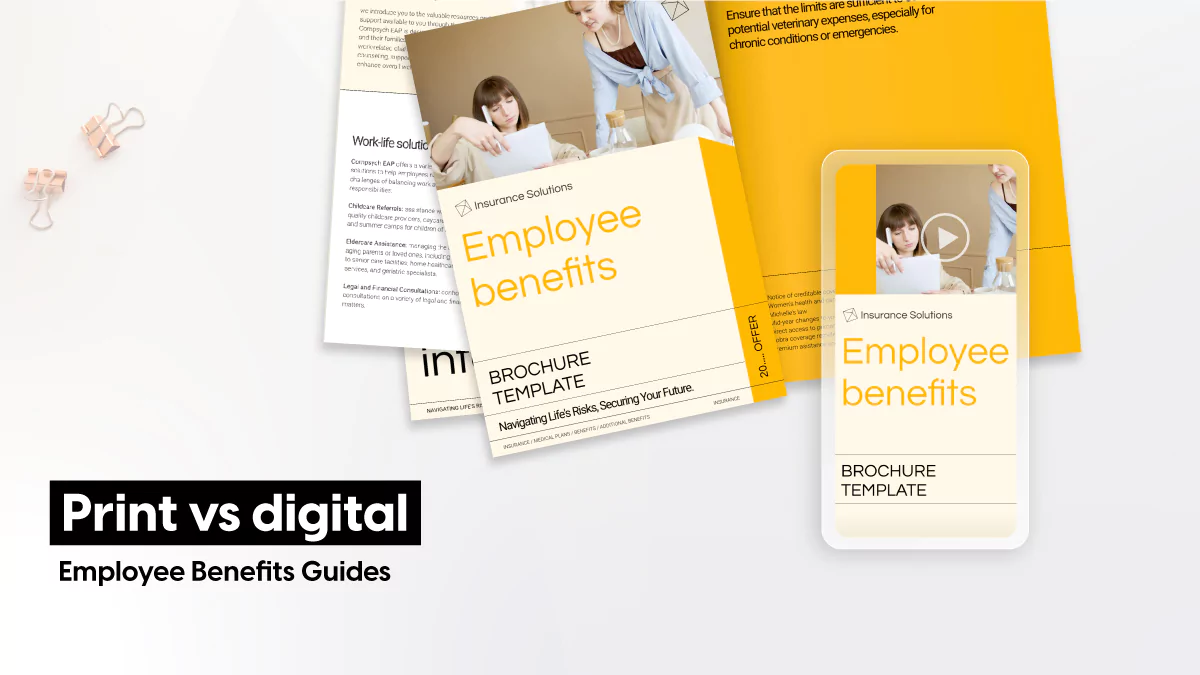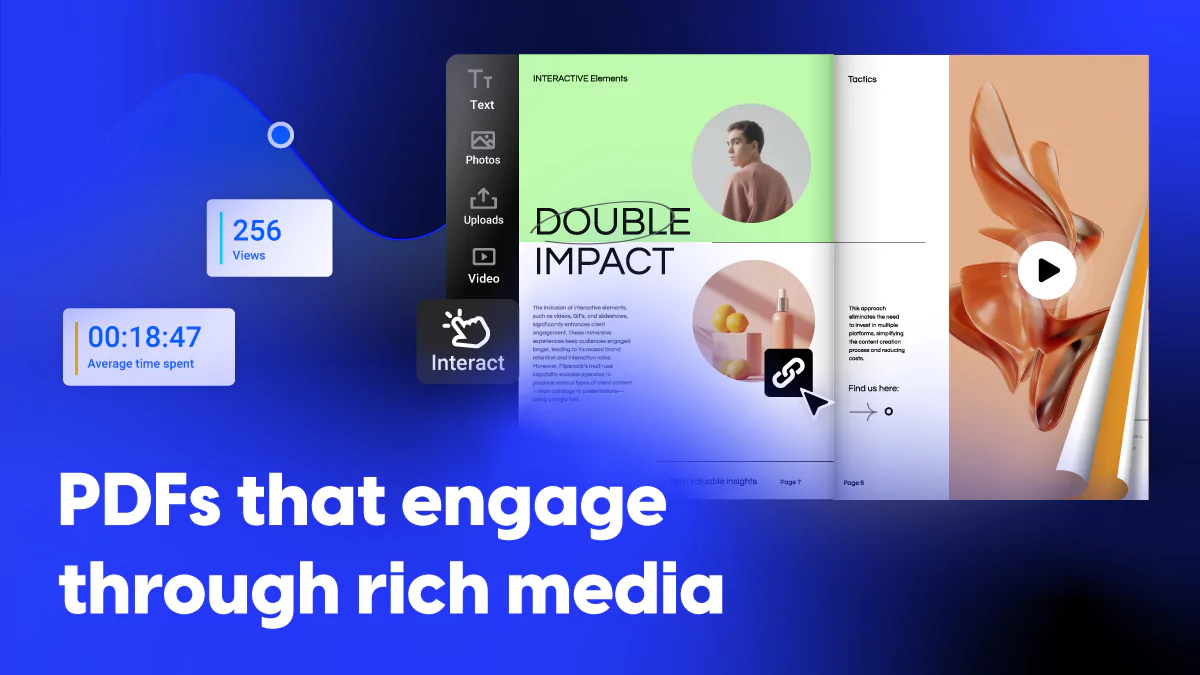Digital vs. printed benefits booklets: which is more effective?
Last updated: January 23, 2025
For years, organizations have used employee benefits booklets to share their perks with their teams. But these days, sticking with a physical booklet might cost you more than it’s worth.
Traditionally, these booklets were distributed between insurance brokers and companies in print format. Then, they moved to Word and PDF files sent by mail. However, employees now want quick, easy access to their benefits info anytime, anywhere.
To attract and retain top talent while controlling healthcare benefits costs, companies need you, an insurance broker, to come up with modern solutions. You must find an efficient way to communicate your benefits programs.
So, where does the industry stand on printed vs. digital employee benefits guides?
Let’s see the impact of digital booklets versus traditional printed ones on company success and how insurance brokers can gain an edge in a competitive market by going digital.

Table of contents
The importance of effective benefits communication
Before moving on to print vs. digital employee booklets, let’s talk about why effective benefits communication matters.
Employee benefits are non-wage perks employers provide in addition to pay. Benefits vary between companies and industries, but they usually include things that improve employees’ well-being and financial security.
Attracting top talent takes more than just a good salary. This is where employee benefits come into play. In a recent analysis run by Flair HR, 22% of employees leave their jobs seeking better benefits. Moreover, 17% say benefit packages are the main reason for staying with their current company.
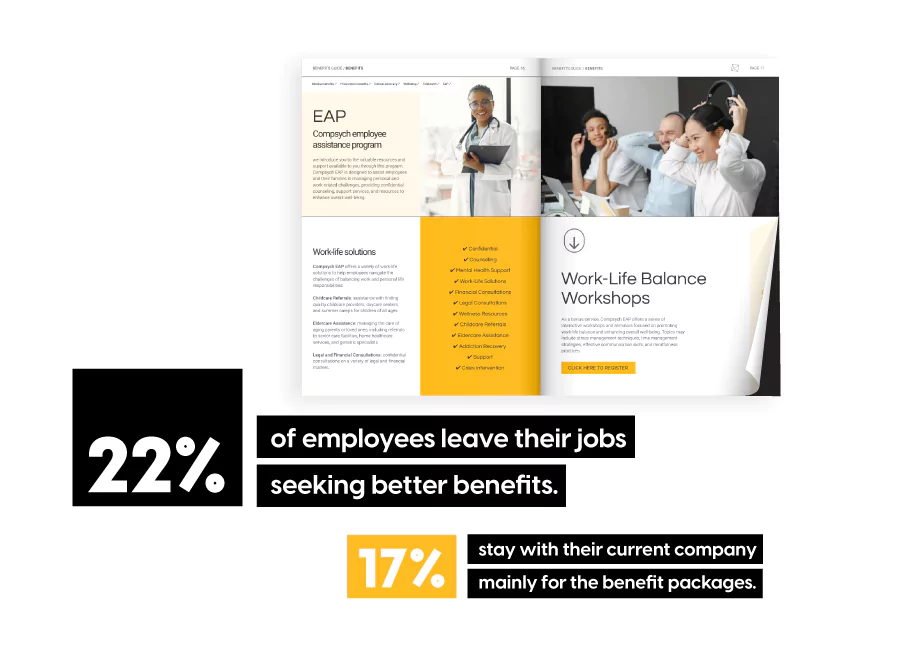
This shows how important it is to communicate employee benefits. It’s not just about offering them. Employees must understand them, too, which also helps during open enrollment.
Open enrollment is a specific period each year when employees can sign up for or make changes to their health insurance plans. This period typically happens once a year and varies depending on the type of insurance. For example, in most states, ACA Marketplace plans have an open enrollment period from November 1 to January 15.
Employer-sponsored plans typically have their open enrollment in the fall, set by the employer.
Not every company in the US has open enrollment, but most employers that offer health insurance have it. Additionally, Medicare and Medicaid have their own enrollment periods, although Medicaid allows applications year-round.
Communicating benefits impacts employee attraction and retention strategies. So, what can insurance brokers do to ensure company leaders and employees understand all their benefits?
This question opens up the way to a deeper analysis of digital employee benefits –
Print vs. digital employee booklets – which one is more efficient?
Digital employee benefits booklets have many advantages over printed ones. So, organizations must understand their differences to optimize benefits communication.
Employee preferences for benefits can vary a lot. Millennials often prefer flexible work and non-traditional perks, while others value traditional benefits like healthcare benefits and retirement plans.
This means companies have different needs, and as an insurance broker, you must understand and meet those needs through personalized benefit guides.
However, think about the cost of printing personalized benefits guides for every company you want to attract.

With digital employee benefits booklets, you can easily send personalized guides to companies. You can also customize each booklet with the target company’s logo and branding to make it more appealing.
These digital employee benefits brochures can also help insurance brokers and companies in many other ways. Let’s review them all.
1. Interactivity
With the right employee benefits booklet builder, digital guides can be interactive and help employees explore their options in a way that catches their eye.
Unlike printed or PDF guides, which often go unread (so, wasted paper and lost information), digital guides can be designed to actively engage employees.
Long, jargon-filled documents can overwhelm people, but a digital format can simplify complex information because you can replace all those hard-to-understand terms with videos and add direct links to other places that will help employees explore the entire benefits documentation.
Also, the interactive elements can easily help companies tell their brand story.
2. Real-time updates
Digital booklets can be updated in real-time, which means that employees always have access to the latest benefits information.
Printed materials have clear limitations in this regard. Once a physical booklet is printed, any changes or updates mean expensive reprints and a lack of flexibility to adapt to evolving workforce needs.
If you’re an insurance broker who works with many companies, keeping printed booklets updated for everyone would be a nightmare. But digital employee benefits guides? They’re a game-changer. With them, you can make updates instantly without spending too much money.
Sure, printed paper has its charm, but when it comes to internal communications within the organization, employees prefer digital technology. Plus, you can forget all bout employee benefit plan printing every time a new person comes on board (who, let’s be honest, will flip through it once, then keep it on their desks until it is appropriate to toss it away).
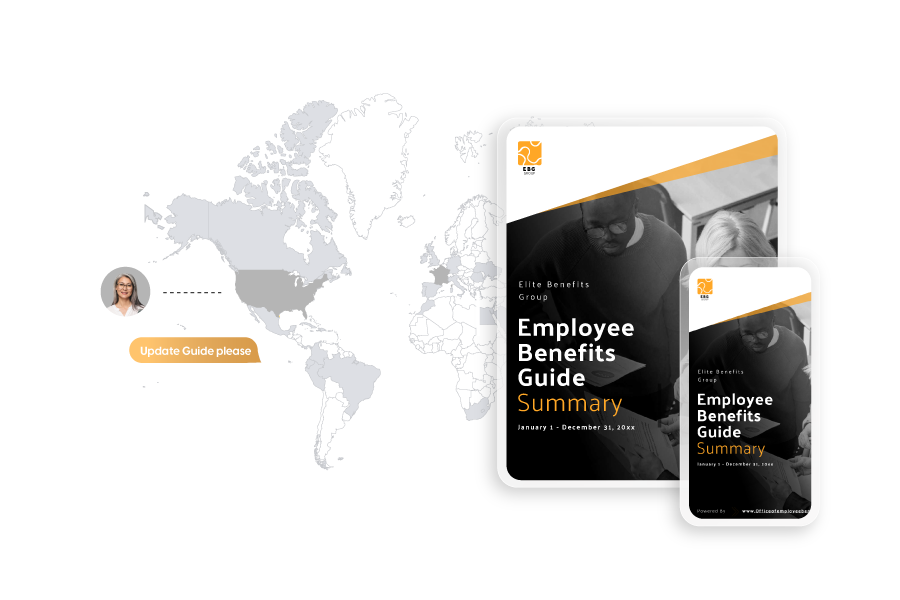
3. Distribution
When it comes to distributing information, digital employee benefits guides offer a clear advantage over printed ones.
Printed booklets need to be physically produced, packed, and shipped to various locations. This process is not only time-consuming but also costly. Once the booklets reach their destination, there’s always the chance of delays or even loss in transit.
Plus, distributing updated versions means repeating the whole process, wasting even more time and resources.
Digital employee benefits guides, on the other hand, are incredibly easy to distribute. With just a few clicks, you can send the latest version to every employee, no matter where they are. Use an employee benefits communication sample email to let everyone know about the benefits. Whether the employees are remote, spread across different offices, or constantly on the go, digital guides ensure everyone gets the information they need instantly.
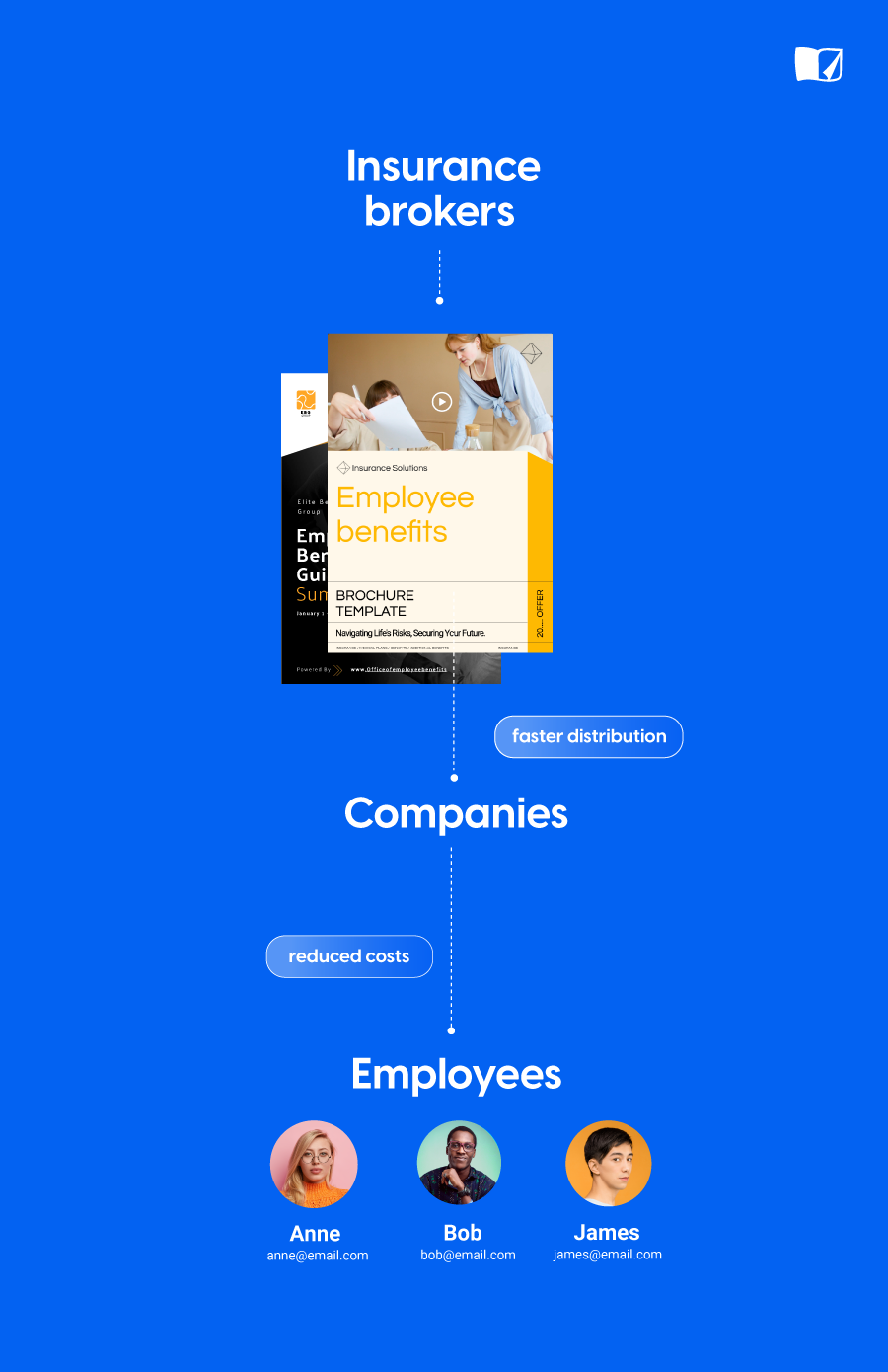
4. Environment
Digital employee benefit guides are not just efficient and user-friendly; they also help the environment. Unlike printed booklets, which require paper, ink, and other resources, digital guides eliminate the need for physical materials.
Think about all the paper used to print employee benefits booklets for every new hire or update. Once printed, these booklets need to be shipped, adding to the carbon footprint. And what happens when they’re updated? More printing, more waste, more impact on the environment.
You cut out all of these environmental costs with digital employee benefit guides.
5. HR teams
A digital employee benefits guide is a recruitment tool that helps human resources attract new talent. They can show the benefits package to potential hires via a dedicated benefits website and provide all the information they need to make an informed decision.
To improve engagement and explain the benefits, they can use a sample employee benefits communication letter and one digital employee benefits booklet.
But, truth be told, these effective benefits guides are always useful for HR teams in their internal communications. Think about it: many employees just toss away their printed booklets, and when they need info from them, they go to HR. Having a link to company benefits will always come in handy.
6. Cost-effectiveness
In the ongoing debate of printed vs. digital employee benefits guides, digital ones are the most cost-effective.
Printed booklets come with a lot of costs. First, there’s printing. Then, there are shipping costs to distribute these booklets to various locations.
Every time there’s an update or a change in benefits, new booklets need to be printed and shipped again, leading to additional expenses. Digital employee benefits guides, however, eliminate these costs entirely. Once created, digital guides can be distributed instantly at no additional cost.
7. Accessibility
With digital booklets, employees can access their benefits information anytime, anywhere, on any device.
Digital flipbooks meet employees’ needs for flexibility and convenience. They can work remotely, travel, or access the information using their mobile devices. It’s far more efficient and effective to create employee benefits guides that can be edited anytime, to which you can add links, videos, or GIFs.
In contrast, printed employee benefits booklets are static, limited in scope, and not so accessible.
8. Analytics
Digital employee benefits booklets offer more useful insights than printed ones through analytics and tracking. These features help HR teams improve communication strategies and employee engagement.
Flipsnack’s analytics and tracking features provide organizations with detailed metrics on how employees interact with the booklet. This allows for data-driven decision-making and continuous improvement.
- Conversion tracking: Flipsnack tracks user interactions and conversions in booklets with links to enrollment forms or benefits providers. This helps HR teams measure the success of campaigns and identify any issues in the process.
- Engagement metrics: Flipsnack’s dashboard shows key metrics like views, time spent on pages, and popular sections. HR teams can use this data to identify the most popular benefits and areas that need improvement.
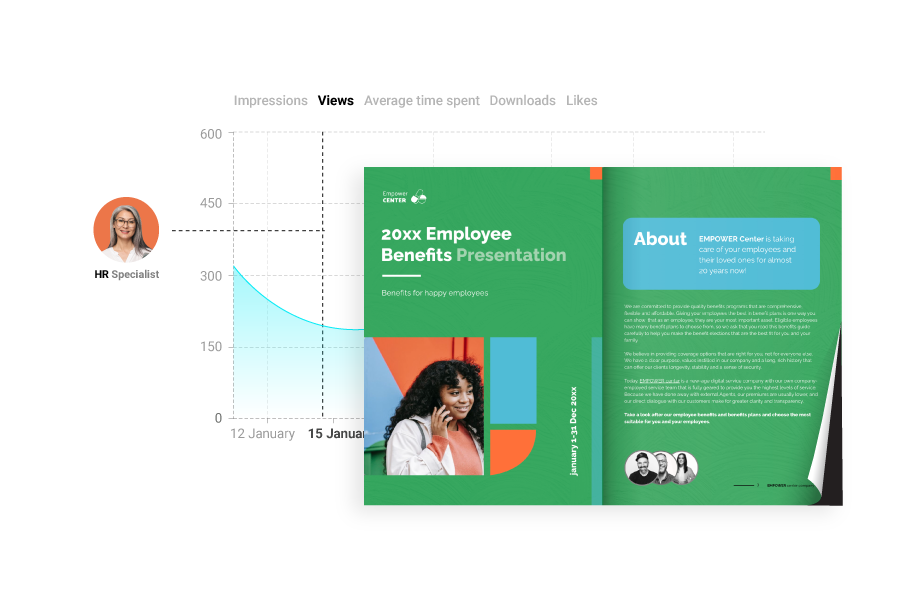
9. Templates and team collaboration for print vs. digital employee benefits guides
We already discussed some of the main reasons why it’s important to create and distribute your content digitally. As an insurance broker, you’re simplifying your clients’ lives, which puts you ahead of competitors.
But there are real benefits even for you as an insurance broker once you go digital. With an employee benefits booklet builder like Flipsnack, you can leverage the simplicity of creating your benefit guides in collaboration with other teammates.
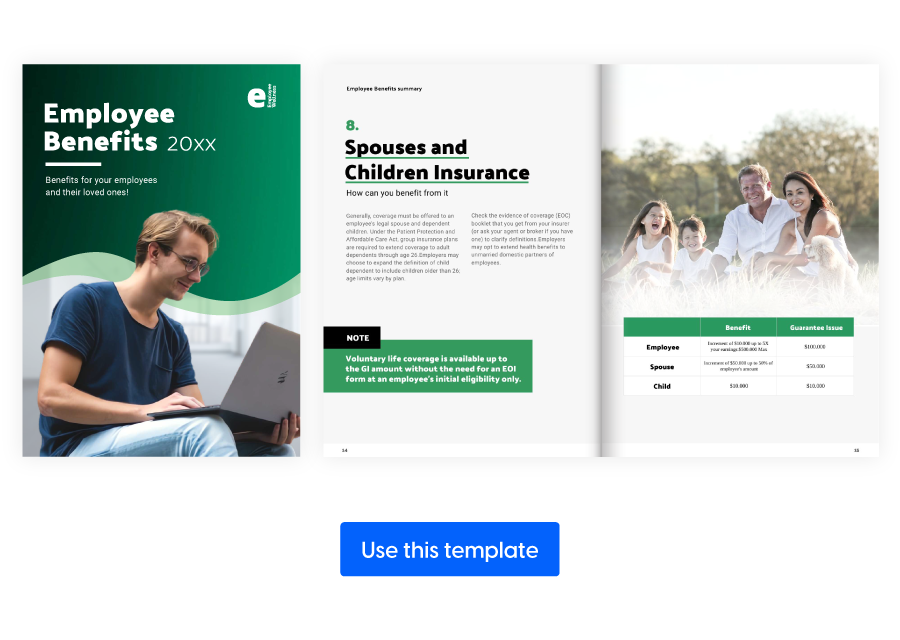
Working on many different projects can get quite stressful at times. Things can get unorganized easily, especially when you work on multiple projects with other colleagues or contributors. To simplify this and give an extra advantage over creating templates in Word or PowerPoint, Flipsnack created workspaces.
A workspace is a dedicated space where one or more people can work on a specific project. You can assign roles and limit editing capabilities while getting everyone’s input before sending an employee benefits package to your clients.
One extra advantage of creating your booklets in workspaces is that you can later save them as branded templates with brand elements locked in place and reuse them whenever you need them.
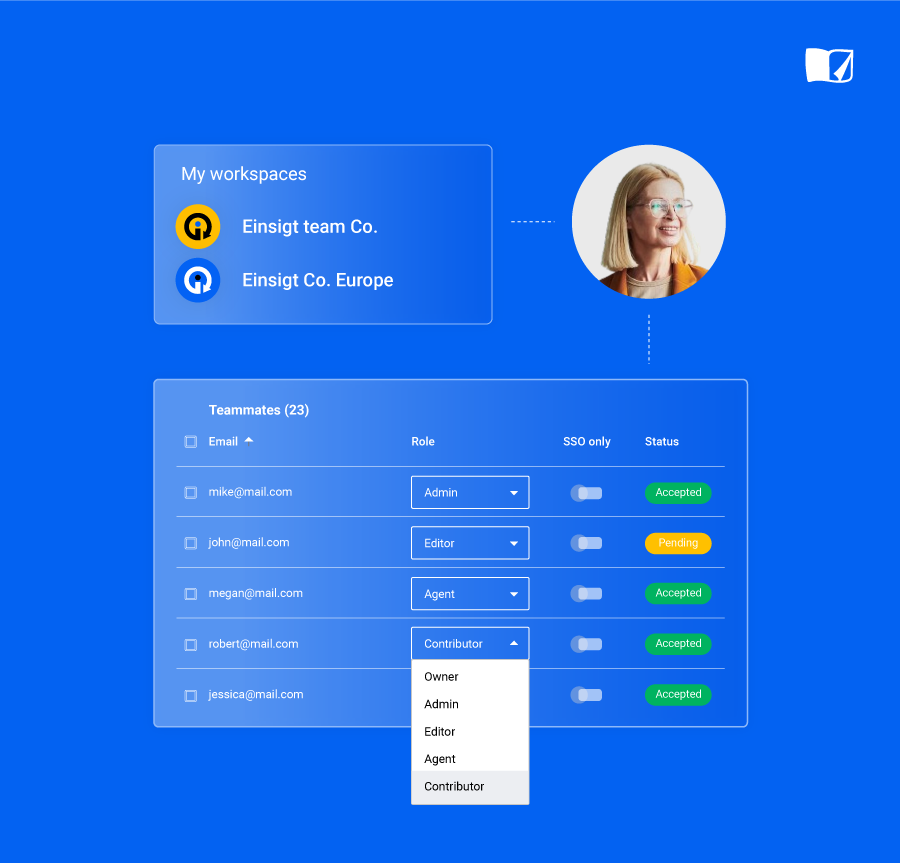
Steps to create an effective digital benefits guide
Since we mentioned Flipsnack a few times already, let’s see how the platform works as a perfect employee benefits booklet builder.
First, as an insurance broker, you need to understand the benefits offerings to better meet client employees’ needs because creating the booklet with Flipsnack is the easy part.
1. Upload your PDF employee guide
Start by uploading your existing PDF benefit booklets to Flipsnack. Then, you can quickly transform them into interactive guides within seconds. You can also upload PowerPoint designs or Word documents.
2. Create employee benefits packages from scratch
Flipsnack’s Design Studio offers easy-to-use editing tools and drag-and-drop features if you want to start from scratch. The platform provides customizable templates for various needs to help you create professional and informative guides without prior design experience.
3. Customize the digital employee guide’s appearance
Make your digital employee guide stand out by adding branding elements such as your company logo, custom fonts, and colors. You can also make the guide interactive with links, videos, and teammates’ insurance photos.
4. Share it privately with your clients
Once your guide is ready, you can publish it as unlisted, meaning it’s accessible only through a shared link. You can also email it or protect it with a password to ensure it reaches only the intended recipients.
5. Track & optimize
Use Flipsnack’s analytics to see how your clients interact with the guides. Track metrics such as clicks and the average time spent on each page. These insights allow you to make real-time updates to improve the guide’s effectiveness.
Go digital with Flipsnack
Switching from print to digital is the right answer for every insurance broker company willing to stay agile and competitive. Companies can use digital booklets to target employee benefits more effectively and ensure employees fully understand their options.
But what does digital mean? Is it a PowerPoint presentation sent via email? Is it a Word template or a PDF document distributed through WhatsApp? These solutions are handy but could be improved in terms of interactivity, versatility, security, and ease of distribution.
That’s why flipbooks created with tools like Flipsnack are a way better solution. With them, you can easily create, distribute, and protect your digital documents on the same platform.
Flipsnack’s tools and templates let companies create interactive, appealing digital booklets that will resonate with employees.
Flipsnack helps businesses create digital booklets that convert. Your business can turn away from print to digital and create an interactive experience for your collaborators with Flipsnack’s digital solution.

